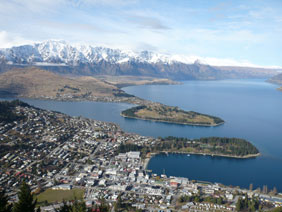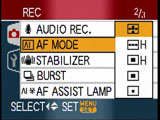Panasonic Lumix DMC-FX30
-
-
Written by Gordon Laing
Panasonic Lumix DMC-FX30 lens coverage
More features : Lenses / Screen and menus / Sensor and processing / anti-shake
Panasonic Lumix FX30 features
Lenses / Screen and menus / Sensor and processing / anti-shake
The Panasonic Lumix FX30 is equipped with a Leica DC Vario-Elmarit 3.6x optical zoom delivering an equivalent range of 28-100mm and a focal ratio of f2.8-5.6; the actual focal length is 4.6-16.4mm and we counted 20 discrete steps when zooming from wide angle to telephoto. The closest focusing distance is 5cm in Macro mode with the lens zoomed all the way out.
|
|
The FX30 is pictured above powered-down on the left and switched-on on the right, whereupon the lens extends by 20mm in just under two seconds. As you zoom the lens in, the barrel actually retracts a little before extending again to 20mm at the longest focal length.
The big claim to fame of the FX30 is being the world’s slimmest compact with 28mm wide angle capabilities. This kind of wide angle coverage is much more useful than the typical 35mm of most compacts, whether you’re photographing a big landscape, are in a situation where you literally can’t step back any further, or simply want to capture a big group shot. So we welcome Panasonic’s strategy of gradually equipping its entire range with the capability and hope other manufacturers follow-suit.
To illustrate the FX30’s 3.6x coverage we mounted it on a tripod and shot the same scene fully zoomed-out, then fully zoomed-in. We then shot the same scene from exactly the same position moments later using the Fujifilm FinePix F30 which is equipped with a more typical 3x range equivalent to 36-108mm.
Panasonic Lumix FX30 coverage wide |
Fujifilm FinePix F30 coverage wide | |
 |  | |
4.6-16.4mm at 4.6mm (28mm equivalent) | 8-24mm at 8mm (36mm equivalent) |
The examples above clearly illustrate while focal lengths of 28 and 36mm sound similar when written down, they deliver considerably different results in practice. An equivalent of 28mm is much wider and offers far greater flexibility whether you’re photographing broad landscapes, large buildings, cramped interiors or big group shots.
Despite offering a longer 3.6x range though, the FX30 can’t quite match the Fujifilm F30 when zoomed-in. The latter has a slight advantage as seen below, but it is minimal. Besides, most people, ourselves included, would sooner sacrifice a little power at the long end for the wider angle capabilities of the FX30. See our fourth features page for a report on the FX30’s image stabilisation features.
Panasonic Lumix FX30 coverage tele |
Fujifilm FinePix F30 coverage tele | |
 |  | |
4.6-16.4mm at 16.4mm (100mm equivalent) | 8-24mm at 24mm (108mm equivalent) |
Panasonic Lumix DMC-FX30 focusing
The FX30 does not allow manual focusing, but there’s a macro mode for close-ups and like other Lumix models, the choice of five different autofocus modes. These modes allow you to choose a balance between number of focusing areas and the speed of operation.
 |
The FX30 has up to nine focusing areas arranged in a grid, and the top 5-area mode uses all of them to automatically lock onto subjects which could be off-centre; this is however the slowest AF mode. A quicker option is the 3-area mode which only considers the left, centre and right focusing areas in the middle row, while the fastest focusing option of all only considers the central focusing area.
The FX30 offers two additional AF modes, again only using a single area in the middle: one operates at normal speed using the central focusing area, while the other Spot focusing option concentrates on a smaller area in the middle.
When zoomed-out, the FX30 can normally lock focus onto most subjects pretty quickly even when using all nine focusing areas. Zoomed-in, the performance inevitably slows and like most compacts the FX30 can find itself searching a little. The 5-area mode typically takes about one second to confirm focus, but by switching to the 3-area mode you can generally halve the time; the single area mode didn’t offer much additional benefit in our tests, but you may have more mileage depending on your subject. Either way, it’s nice to have the choice of focusing modes for situations when you need quicker response or better recognition of off-centre subjects. Interestingly the FX30 does not have face detection; this is a feature being introduced with the forthcoming Lumix FX33, so if it’s important you might prefer to wait for this new model.
Now let’s take a closer look at the FX30 screen and menus.




